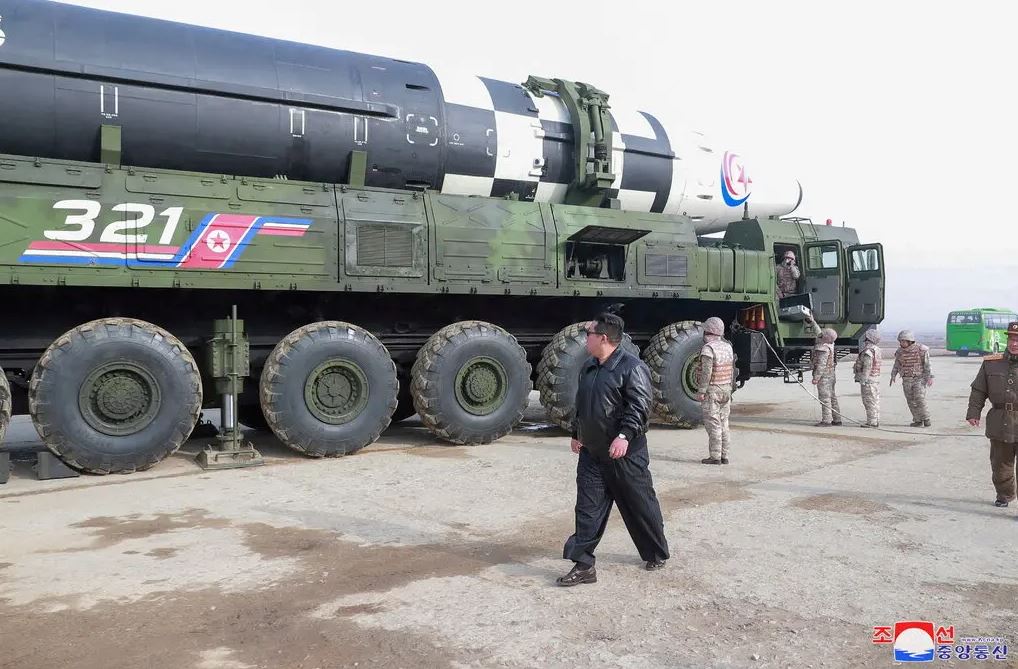According to the military of South Korea, North Korea fired three ballistic missiles, one of which may have been an intercontinental ballistic missile, in the direction of the seas off of its east coast on Wednesday. The launches took place even as President Biden was wrapping up a tour to the area, where he pledged to bolster deterrence against the rising nuclear danger posed by North Korea.
In a separate development, thirty South Korean F-15K fighter planes carried out a “elephant walk” on the runway while getting ready to take off with their full complement of armaments.
South Korean military experts have said that it seems the first missile that North Korea fired on Wednesday was an intercontinental ballistic missile (ICBM). However, according to the authorities, the missile only travelled 224 miles, which suggests that North Korea did not wish to send the missile on a full ICBM trajectory over the Pacific while President Biden was in the air on his way back to Washington after a trip to Seoul and Tokyo.
The United States Indo-Pacific Command said that the launches did not constitute an imminent danger to the United States or its allies, but they did underscore the “destabilising effect” that North Korea’s weapons programme has had. South Korea warned that the North’s continued testing of its weapons will only “deepen its isolation” and described the tests as “a grave danger” to world peace. It also advocated for the stricter execution of existing restrictions.
The latest intercontinental ballistic missile test that North Korea carried out was on March 24, 2019, breaking a self-imposed ban that had been in place since 2018.
Despite the fact that North Korea has announced its first case of the coronavirus, the missile tests that were conducted on Wednesday were a clear indication that the government is moving forward with a new cycle of escalating tensions on the Korean Peninsula. It was also North Korea’s first public reaction to President Biden’s recent trip to the region, during which he met with the heads of state of South Korea and Japan and pledged to step up measures, including joint military exercises, to help deter the growing nuclear and missile threat from the North.
Mr. Biden said that the United States of America will strengthen the alliance and heighten deterrence in response to the danger posed by North Korea at a meeting with President Yoon Suk-yeol of South Korea in Seoul on the previous Saturday. Mr. Biden and Mr. Yoon made the announcement that they would investigate possible means by which they may increase the scope of cooperative military drills that had been terminated or reduced during the administration of President Donald J. Trump.
On the 10th of May, while Mr. Yoon was being sworn into office, he presented “an ambitious plan” to drastically enhance both the economy of the North and the quality of life of its inhabitants. However, in the same vein as his conservative predecessors, he appended a crucial proviso to his proposal: “such economic largess would be achievable only if North Korea actually begins on a road to full disarmament.”
The launch of missiles on Wednesday provided unequivocal evidence that North Korea has no intention of engaging in nuclear disarmament negotiations in the near future. Kim Jong-un, the leader of North Korea, said once again in a speech he gave in April at a military parade that took place at night that his country’s citizens should be ready for a standoff with the United States “for a lengthy period of time.” In addition to this, he made a solemn oath to “grow his arsenal of nuclear bombs, intercontinental ballistic missiles, and other delivery vehicles at the rate that is physically achievable.”
To prepare for the first summit meeting between Kim Jong-un and Donald Trump in 2018, North Korea has proclaimed an end to all of its nuclear and intercontinental ballistic missile (ICBM) testing. However, diplomatic efforts were ultimately unsuccessful, and no deal was reached about the dismantlement of North Korea’s nuclear programme or the timing of the lifting of sanctions.
Since then, Mr. Kim has promised to find a “new method” to deal with Washington and has begun testing a range of new missiles at his country’s facilities. Analysts saw his actions as increasing the stakes in his conflict with Washington and its allies by fast developing a fleet of nuclear-tipped missiles and revising his country’s nuclear strategy. This was perceived as raising the stakes in his confrontation with Washington and its allies.
In spite of decades of diplomacy and sanctions, North Korea’s nuclear capabilities have only become stronger and more deadly, and the latest cycle of tensions underscores this painful fact for both Mr. Yoon and the administration of President Joe Biden.

